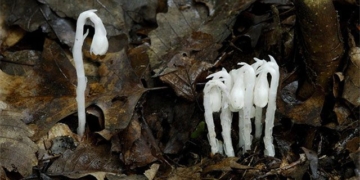There is no doubt that medical masks have become one of the symbols of the Covid-19 pandemic. Masks help people protect themselves and each other from pathogens, particularly the SARS-CoV-2 virus.
However, the downside of masks is that most of them are made from plastic. Disposable medical masks are thus certain to become an environmental disaster in the post-pandemic world. Estimates suggest that globally, 129 billion masks are used and discarded every month, which is equivalent to 3 million masks every minute.
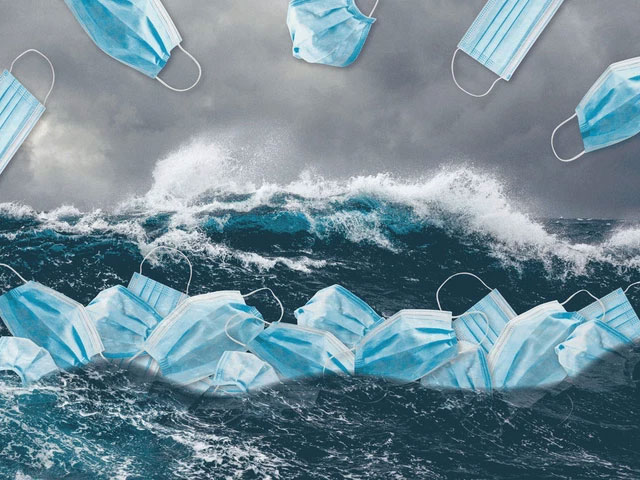
. Estimates suggest that globally, 129 billion masks are used and discarded every month.
Once discarded, masks become a type of waste. They have been and continue to be found in every corner of the world, from city sidewalks to vast oceans.
Masks have been recorded drifting onto uninhabited islands in the Pacific. They have wrapped around the bodies of octopuses off the coast of France.
The elastic bands have ensnared turtles, birds, and many other animals. Fish may be ingesting plastic strands released from the polyester fabric woven into the masks to make them water-resistant.
Ultimately, masks that were once meant to protect humans will return to threaten our health, as the materials they are made from, primarily plastic, begin to break down at a micro level, creating microplastic particles and fibers.
In fact, the pandemic has provided a tremendous business opportunity for the giants in the plastic industry – Big Plastic. John Hocevar, ocean campaign director at Greenpeace USA, stated: “The plastic industry sees COVID as an opportunity, claiming that reusable items are dirty and dangerous, and that single-use plastics are necessary to keep us safe.“
In one way or another, they have pushed that message, culminating in their PR campaign in July 2020. When the president and CEO of the Plastics Industry Association testified before the U.S. Congress, he argued that single-use plastics were a health necessity during the pandemic.
For the first time in human history, a president of the plastic industry could proudly and boldly declare, “Plastic saves many lives.“
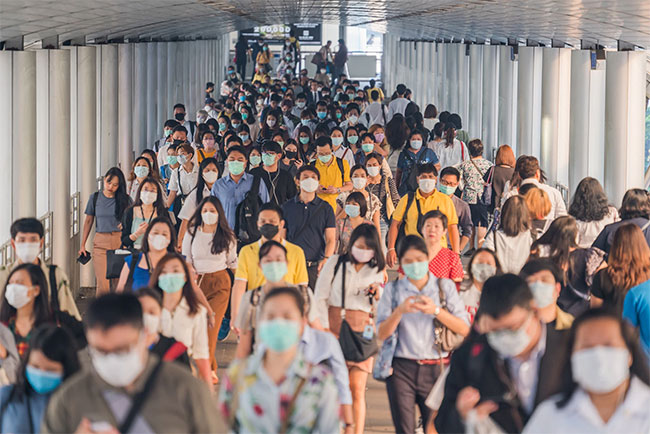
Currently, wearing masks is an essential part of life.
This fear-based media campaign has been successful and remarkably so. According to a report from the Organisation for Economic Co-operation and Development, global consumption of single-use plastics surged by 300% in 2021 since the pandemic began.
The demand for masks even increased as the pandemic progressed. In the UK alone, a study in December 2021 showed that the consumption of disposable masks increased by up to 9,000%.
And as more transmissible variants like Delta and Omicron emerged, public health officials promoted the use of heavier masks such as KN95 and N95.
Cellular Level Disaster
As we enter the third year of the Covid-19 pandemic, research has expanded beyond the initial concerns of environmental advocates, raising new worries.
Sarper Sarp, a chemical engineering professor at Swansea University in Wales, conducted a study testing the degradation of nine types of disposable masks.
After soaking them in water and letting them sit, Sarp and his team discovered that the masks were releasing ultra-small plastic particles, down to the nano size. The leachate from these masks now resembles a toxic tea.
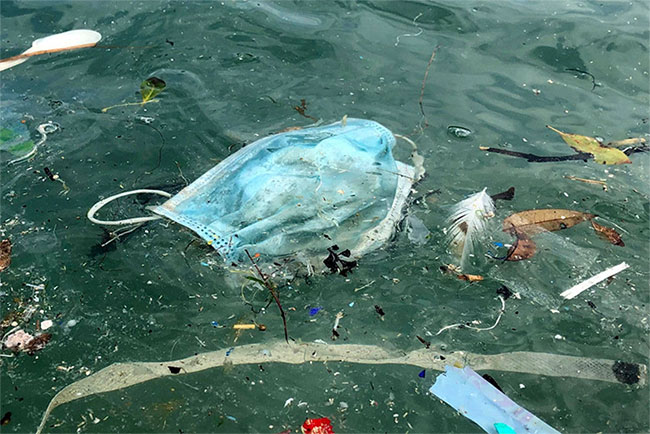
The leachate from these masks now resembles a toxic tea.
The research shows that disposable masks can release nano silicon particles, heavy metals such as lead, cadmium, copper, and even arsenic.
Sarp mentioned that he was surprised by the concentration of hundreds to thousands of toxic particles released from each mask in a short time. According to Sarp, these particles may have poisoned entire marine ecosystems, food chains, and contaminated freshwater sources.
The presence of nano silicon particles is particularly concerning. Silicon is a common material in healthcare products due to its ease of sterilization and storage. “But when it comes to nano size, that’s a completely different story,” Sarp stated.
Micro-sized microplastics harm ecosystems. However, our bodies can filter them out relatively effectively, from the lungs to the digestive system.
In contrast, nano-sized particles are smaller than a micron by 1,000 times. Whether made from plastic, silicon, or other materials, they can penetrate cell membranes. Recent studies on nano silicon particles have indicated they can become small bombs causing cancer by affecting cellular DNA.
Multiply that by at least a few hundred nano particles released from each mask, among the 50,000 masks discarded every second. The picture becomes extremely alarming. “As both a scientist and an environmental expert, I believe this is a very urgent situation,” Sarp said.
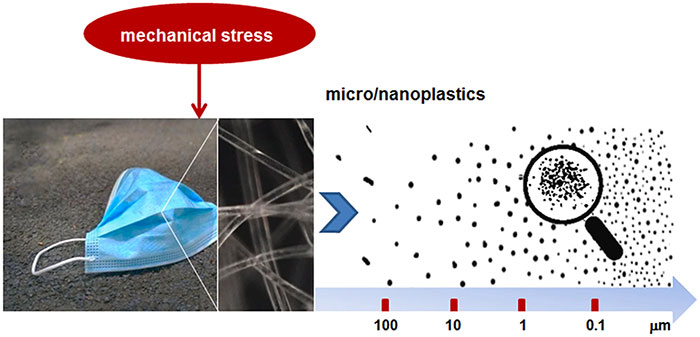
Micro-sized microplastics harm ecosystems.
Market Efforts
In contrast to the giants in the plastic manufacturing industry pushing for single-use masks, the efforts to limit and mitigate its consequences are falling on a few scientists and progressive entrepreneurs.
For example, in the UK, we see a supermarket chain, Morrisons, partnering with ReWorked, a recycling company planning to collect disposable masks and turn them into useful items like plant pots or trash bins.
In Canada, a specialized plastic recycling service named TerraCycle has been collecting disposable masks for processing. In the U.S., a group of engineers at MIT is collaborating on a startup called Teal Bio.
Their goal is to create recyclable masks, or in other words, masks that can be reused multiple times. The company is initially targeting healthcare workers, and they are working to perfect such an N95 mask for medical personnel.
Tony Casciano, CEO of Teal Bio, explains their product: “Users [healthcare workers] can disinfect the mask after use with alcohol wipes or standard hospital cleaners, and then replace the filter after their shift.“
According to Teal Bio, a recycled mask can last for an entire year. Its filters can also be biodegradable, as they are primarily made from a material Casciano refers to as “a special wool” made from “unique sheep.”
Although Casciano did not elaborate on this so-called special wool, the idea seems to align with a concept from 2017. That year, scientists in New Zealand bred a special sheep that could produce ultra-fine wool, which could be woven into filters for medical masks.
Teal Bio’s CTO, Jason Troutner, stated that their product has a significant advantage in the current context, as it promotes sustainability.
Troutner and Casciano are confident they have enough supply of the special filtering wool to scale production to meet the demands of various consumer groups. However, according to Casciano, the company will initially focus on the target market of healthcare workers.
He also did not disclose the expected price of this mask, only mentioning that Teal Bio’s product will provide “significant savings on a per-mask basis for a reusable mask over the course of a year.“
Thus, this solution appears to be limited to a niche market, and the price of such a mask may not be affordable for many average consumers.
Sarp, the Welsh scientist, stated that Teal Bio’s efforts are commendable. “But they need to be considered on a larger scale. We are producing hundreds of millions of masks every day.“
A single company in the U.S. or the UK will not be able to solve the problem,” especially in the case of Teal Bio, if their market is limited to the healthcare sector.
“Environmental health is human health”
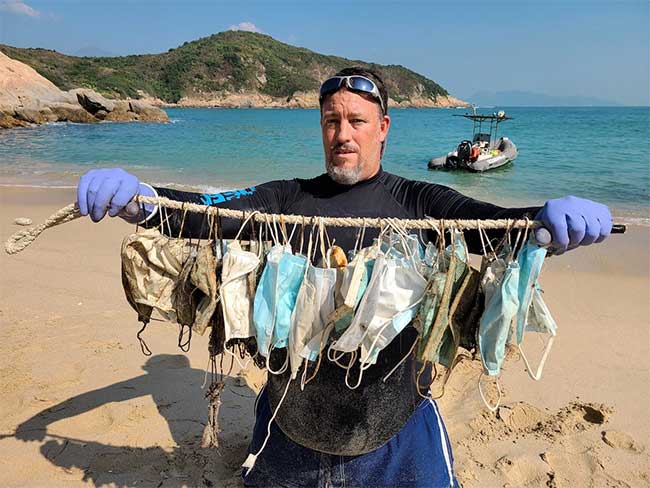
Covid-19 has caused not only a pandemic for humans but has also left its footprint on the environment.
Climate change and extreme weather events have been increasingly prevalent in recent years, teaching humanity an important lesson. Our happiness is indeed heavily reliant on how harmoniously we live with the ecosystem.
As Hocevar stated: “The health of the environment is the health of humanity.” Therefore, it would be naive to think that the Covid-19 pandemic will end when the disease finally becomes endemic.
Covid-19 has not only caused a pandemic for humanity but has also left its mark on the environment. Billions of single-use masks will remain there, perhaps for hundreds or even thousands of years, much longer than we anticipate.
Thus, now more than ever, it is time for us to take action to address that massive waste pile and mitigate the long-term consequences it may impose on the ecosystem.
“Across the globe, there are truly promising approaches emerging. What we need to do is to bring them together. We need to make governments understand that they must act and then provide the necessary resources,” Sarp stated.
“At that point, we can hope to begin addressing the issue before it becomes unmanageable.”


















































